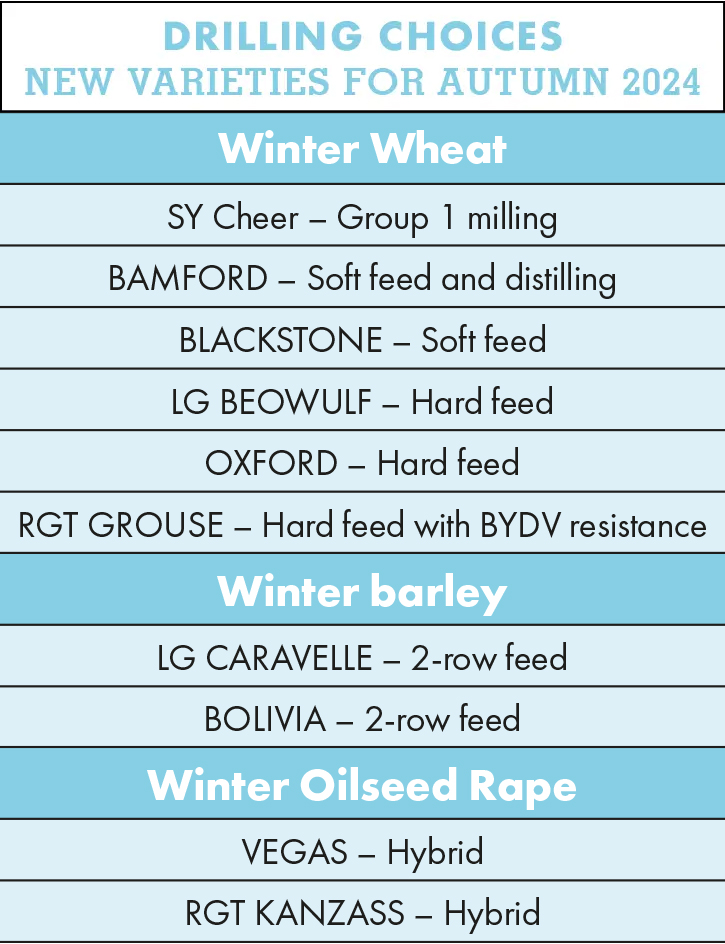Across 2,500 acres of owned and contract-farmed land, A & R Fraser seeks to achieve a balance of crops that ensure a balanced workload and a respectable return for its clients. Delivering this involves all members of the family from brothers George and Jonny and parents Andrew and Rosalind.

The rotation is based around combinable crops with a focus on milling wheat. “The wheat area is predominantly milling types based on the belief these were likely to attract a strong market premium for the 2024-25 marketing year and would therefore be more profitable than feed,” says George Fraser.
In past years, feed wheats have made up a large part of the crop area and, with futures prices less attractive, are likely to do so again this autumn.
“Skyfall and Crusoe are the preferred milling varieties while Graham and Fitzroy have performed well as feeds. In 2023, Fitzroy accounted for roughly 300 acres. It out-yielded Graham by about 0.5t/ha and was on par with the milling wheats at 9.75t/ha. In 2022, it yielded 12t/ha but this was exceptional year, but now we know it can perform, we will be sowing it again this autumn,” says George.

In recent years, the business has made several changes to its crop production regime in a bid to support profitability. In 2016 the farm moved to liquid fertiliser to save on labour and machinery costs in the handling of bagged product while in more recent years, crop establishment has been based on a no-till approach to save on fuel and metal costs.
“Some varieties suit this system better than others, so it can pay to research variety options before making selections. This is how we arrived at Fitzroy despite it not being on the Recommended List. It looked good in trial, so we gave it a go,” he says.
A key consideration for A & R Fraser when making variety choices is the light soils that cover most of its farmed area at Charlton, near Shaftsbury, Wiltshire.
“Some of our ground could be considered of low quality and prone to drought. It was noticeable that the Fitzroy seemed to tolerate this better than the Graham as was visibly greener for longer.
“This could be due to its better disease resistance which may also explain its later maturity. It tends to ripen shortly after the Crusoe which suits our harvest priorities,” says George.
Management benefits are one of the main attractions of Fitzroy. Unlike the milling wheats it doesn’t receive a T3 spray while the T0 is trace elements and a plant growth regulator only.
The T1 is a standard mixture of prothioconazole and SDHI while the T2 is a triazole, SDHI and strobilurin mixture.
“It also has a vigorous growth habit. We have found this beneficial in minimising damage by slugs and in competing with grassweeds. The latest safe sowing date of end of January is also appreciated when autumn conditions are less than favourable,” he says.
An often-overlooked consideration when selecting varieties is the risk that a variety will suddenly breakdown to disease as happened when the ‘Warrior’ race of yellow rust swept across Europe in the early part of the last decade.
“Varieties occasionally suffer a rapid fall, so having a little diversity in the genetic base can be valuable. Risk management in all its forms is something as an industry we could do better. Fitzroy provides an opportunity to spread the growing risk through a mix of parentage that doesn’t exist in our other varieties,” says George.
At 92cm tall Fitzroy also fulfils another requirement: the need for straw.
“We have several muck-for-straw arrangements with local farmers and also sell straw off the farm, so its height is appreciated. It also looks good in the field. Not quite as good as the Crusoe, but better than many other varieties,” he adds.



